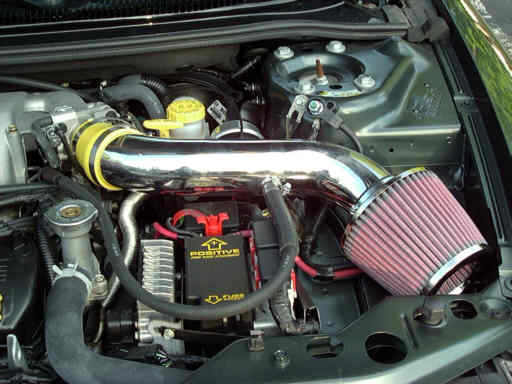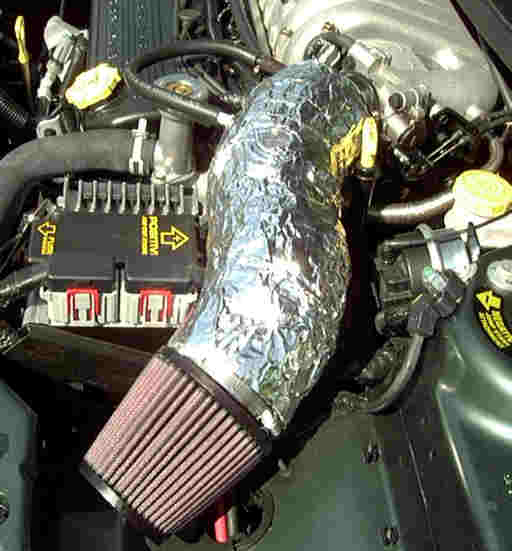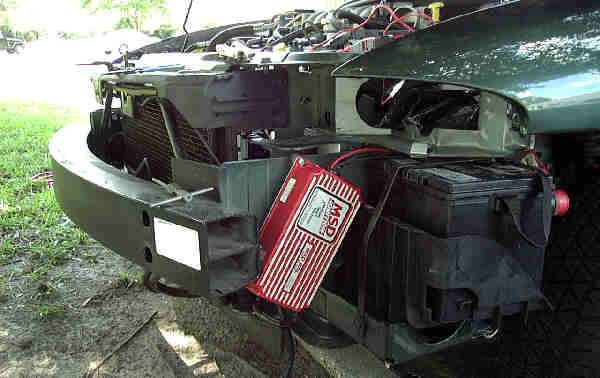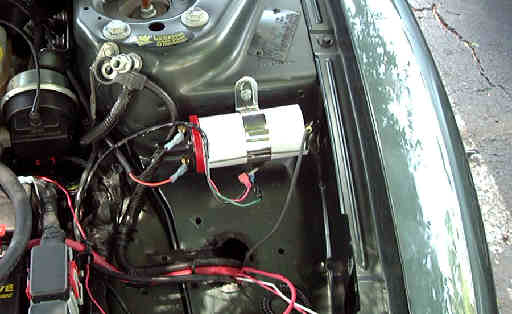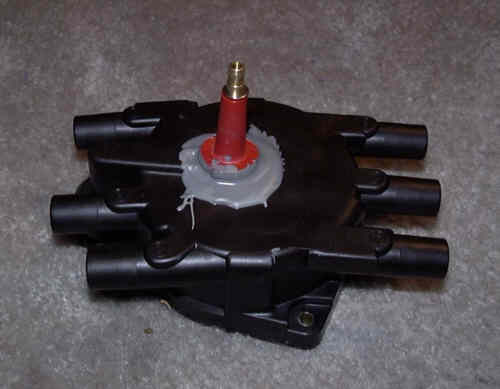|
Never Forget |
|||||||||||||||||||||||||||||||||||||||||||||||||||||||||||||||||||||||||||||
|
|
|||||||||||||||||||||||||||||||||||||||||||||||||||||||||||||||||||||||||||||
EngineInteriorExteriorCar InformationThe Society of Automotive Engineers Car EnthusiastsCar Parts Vendors |
My Ride's EngineMy ride came stock from the factory with a 2.5L Mitsubishi V-6 (follow the link for engine information), mated to a 41TE Ultradrive transmission configured for AutoStick. This engine/tranny combo is rated at 168 HP and 170 ft-lbf of torque (to the wheels: 126 HP (!) and 127 ft-lbf torque). With all of the modifications listed below, I estimate my engine is able to develop about 192 HP and 185 ft-lbf of torque (to the wheels: 140 HP and 143 ft-lbf torque). These numbers were arrived at from 0-60 MPH times of 10.3 (stock) and 8.4 (mine) seconds, as well as dynomometer tests of similar rides with all but the ignition upgrades reporting about 193 HP and 180 ft-lbf of torque. Air InductionI installed the Dreamspeed Performance Engineering air induction tube. Another V-6 ride equipped with this tube has been dyno-tested by another member of Stratusphere to give a gain of 6 HP over the factory air intake. This is due to the fact that the Dreamspeed tube removes the air restriction provided by the stock air filter housing and flex joints in the stock intake hose. I have noticed an average gain of 2 MPG.
The Dreamspeed tube looks a lot better than the ABS tubing I had previously. I have noticed a slight performance improvement over the ABS tube, and it looks like that the improvement is due to the fact the the Dreamspeed tube is "optimized", as it were, to flowing air, while the ABS is "optimized" to flow water.
Instructions are available on this website on how to build your very own induction tube. Cat-Back ExhaustI had installed a 2.5" cat-back exhaust. I went with the 2.5" as opposed to the 3" because I could not find 3" mandrel bends that would physically fit under the vehicle in place of the stock piping, and because I would have run into issues concerning excessive cooldown of the exhaust coming out. Excessive cooldown results in a colder, more dense exhaust that requires the engine to work harder just to force the stuff out. This means that any gains made by reducing backpressure due to the larger piping are pretty much wiped out. In any case, the 2.5" piping is quite adequate for this engine. I have noticed a marked increase in gas mileage. For instance, I don't know of any other cloud car (even my previous ride) that is capable of getting 35 instantaneous MPG going 75 MPH down the highway. Keep in mind that the MPG reading was for a convertible. Not bad at all... I have installed a Borla turbo muffler, and replaced the stock resonator with a Thrush Magnum Glasspack muffler. The Thrush does an outstanding job of reducing noise than either the previous Dynomax or the stock resonator. There's only a very slight drone at idle, and the interior noise strongly resembles the noise from a stock setup, with the engine valvetrain noise actually being louder than the exhaust noise. There was no change in performance when the Dynomax was swapped out for the Thrush. I have the best of both worlds now; a really quiet car, and the performance of a low-restriction exhaust! As for any fears I had about burning valves, they have proven to be unfounded. Valve burning is a consequence of running very lean, not necessarly as a consequence of reducing backpressure. In fact, one would want to have hot exhaust gases stay around the valves in as little time as possible, which is enhanced by removing exhaust restrictions and therefore lowering backpressure. A nice byproduct of reducing backpressure is, of course, greater performace as the engine gets to transfer work to the wheels that would otherwise have to be spent pushing exhaust gases out the tailpipe. For more information about exhaust and backpressure, go to the Cloud Car Exhaust FAQ page. Information is available on this website about how to make your own cat-back exhaust. MSD IgnitionI installed this ignition to replace the stock ignition system, and to make it easier to work on should the stock coil ever fail. I had to come up with a transistor switch to bypass the transistor switch mounted internally in the stock distributor. It's a pretty simple circuit; I used an ECG2389 N-channel power MOSFET, with a 1 k-ohm resistor tied between source and gate. The PCM firing signal went to the gate, the source was tied to ground, and the drain went to the MSD 6AL ignition input. I did this because the 6AL cannot run off the PCM firing signal alone; it must connect to the negative terminal of a coil, and that's what I was able to simulate. I can also drive the Blaster 2 Coil coil directly with my circuit, should the 6AL ever fail. Do not use any RadioShack transistors! I used a IRF510 N-channel power MOSFET from RadioShack, and it lasted about 6 days before it died. I was lucky that it decided to die just as I pulled into a parking spot at my apartment building!
I also had to modify a 2.5L distributor cap to accept a primary terminal. That was pretty easy. MSD sells a coil wire kit to modify a distributor cap to accept an external tower, and it includes a ignition coil wire.
I have noticed about 1 MPG gain over stock, and my engine doesn't "pop" quite so much when I'm engine-braking in AutoStick mode. I have also noticed that my exhaust tip does not have any carbon deposits at all... This is a good thing! Instructions are available on this website on how to install a capacitive-spark discharge ignition system. Spark Plugs and Spark Plug WireI'm currently using Bosch +4 Platinum spark plug wires, along with a Bosch Premium spark plug wire set. I'm very pleased with this combination, as it has given me a 26.4 MPG with the other mods listed above. I was using a set of Magnecor spark plug wires, but I've found that, although the Magnecor set performs better than the stock garbage wire set that came with my car, they don't perform as well as the Bosch set. For instance, for the same driving trip that I got the 26.4 MPG with the Bosch wire set, I was only getting about 24.2 MPG with the Magnecor/Bosch +4 combination. Also, with the Bosch Premium wire set, the engine popping mentioned above is almost completely gone. I'm pleased with this, as well. Below is a table of resistance values of the Magnecor wire I switched out, along with the corresponding Bosch wire resistance value. Keep in mind that a lower resistance value is better, as the lower resistance allows more of the spark from the ignition to reach the cylinder for combustion, and wastes less of the spark inside of the wire.
I've also performed a comparison between different types of spark plug that are specified for the 2.5L V-6. I compared the recommended plug found on my ride's VECI sticker, two copper-core plugs, a platinum plug, and the +4. The results are listed below. Of surprising note is the fact that the +4 has lower resistance than any of the other plugs tested, which contradicts the popular notion that platinum is no good for performance.
Cloud Car Performance Module (CCPM)The Cloud Car Performance Module (CCPM) was a device I put together and programmed. Based on the venerable MC68HC11, a powerful 16-bit microcontroller, the CCPM is a piggyback computer that modifies spark timing signals. It modified the spark timing signal coming out of the PCM according to both engine RPMs and engine loading. It is an improvement over the Superchips ICON, which only modified the spark timing signal according to engine RPMs. It also is an improvement over the Venom 400, which modifies throttle-position sensor signals. My unit was a prototype for a product that I was hoping to develop enough to sell. Right now, there is no easy way to program custom spark maps into the CCPM. It's just as well, because there currently exists no PC program that would allow the user to modifiy the spark map! Besides, due to both a lack of interest and a lack of a experimentation platform (a 2.5L V-6 cloud car), this project has been placed on indefinite hold. The CCPM was to have the following specifications:
I don't have the CCPM in production. Also, Superchips is discontinuing the ICON product line. However, there are still ICONs out there. For those of you out there who want to know where to get a Superchips ICON for your cloud car, you can go to Performance Ford, and go to the Ignition Products listing under the "Ford - Lincoln - Mercury - Mazda" listing. These ICONs normally sell for $395; however, Performance Ford sells them for $355. Shipping is extra, of course. Now, a word for all you 2000 model year cloud car owners: Superchips does not yet have a timing curve for your vehicle. You'll have to specify that you want a 1999 model year timing curve. Also, if you plan on modifying the timing curve in the ICON (well, the ICON actually stores timing curve adjustments to the stock timing curve), you'll want to buy the optional ICON programming kit for $100. I also have ICON timing curves here for download:
TPS ModificationBefore I explain what the TPS mod does, a little engine theory should be read in order to understand the explanation. Depending on what type of vehicle you own, the TPS serves either one or two different functions. The primary function, that of telling the PCM what the throttle plate is doing, will be discussed first. The PCM has to know what the throttle plate is doing, so that it may enter one of a number of operating modes. These modes include (but are not limited to) normal idling, normal acceleration, decceleration, normal cruising, and wide-open-throttle (WOT) acceleration. For each of these cases, the PCM will adjust fuel delivery based on what it perceives what the engine needs. For normal idling and cruise modes, the PCM primarily reads the output of the manifold absolute pressure (MAP) sensor and intake air temperature (IAT) sensors to determine how much fuel to inject. In conjunction with the crankshaft position (CKP) sensor and camshaft position (CMP) sensor, the PCM will also adjust fuel injector and ignition timing. Finally, in the case of idling, the PCM will adjust the idle air control (IAC) to regulate RPMs to around 750 or so. Both modes are what are known as "closed-loop" modes, or modes in which the PCM has to continually adjust its fuel output to keep emissions levels as low as possible. In both cases, the PCM monitors the TPS to determine if it should exit its current mode, and enter one of the modes mentioned below. Normal acceleration and decceleration modes are also closed-loop modes. In acceleration mode, the PCM will measure how much the throttle position has changed, and will momentarily adjust fuel and ignition timing. The PCM will momentarily do this because its primary fuel and ignition sensors have what is known as lag time; that is, it takes more time for the IAT and MAP sensors to adjust than the amount of time that the PCM has in order to properly cause the engine to rev up. This means that, for a brief period of time, the PCM cannot trust the MAP and IAT sensors for fuel and ignition control, and must compensate until it can again trust the MAP and IAT sensors. The PCM uses the TPS here to determine what the MAP and IAT sensors would do, and goes from there. If the TPS were not installed, the engine would stumble and lose a good portion of acceleration, and the engine would also consume too much fuel for what it needs, which would lead to increased emissions as well. When a predetermined amount of time goes by (on the order of milliseconds), the PCM will again trust (and use) the MAP and IAT sensors for fuel and ignition control. WOT acceleration is an open-loop mode; that is, the PCM does not constantly vary fuel output to meet emissions levels. The PCM will monitor the TPS for a large voltage (>3.7 volts) and uses this to determine that the driver has mashed the gas pedal to the floor. Notice that a majority of these modes are "closed-loop." This means that the PCM has to minimize emissions. Since the OBDII legislation controlling the design of newer engines mandates heavy emissions controls, this led to the necessity of the PCM having to monitor TPS voltage to begin with in order to determine whether or not the TPS was failing or wearing out due to normal wear and tear. The PCM also has to adjust for manufacturing tolerances between TPS's used in our clouds, which means that the PCM has to be able to get the same output for one TPS that it would for another TPS that had a slightly higher average voltage output. With this in mind, the PCM will monitor TPS output during engine starting and warm-up, and compare TPS output against the other engine sensors to determine what the throttle is actually doing. Based on what it finds, the PCM will adjust what it thinks the TPS is doing, and will use this information (instead of actual TPS voltage) to control the engine. Now, the second main function (for automatic transmissions only) that the TPS serves is to tell the TCM what the throttle plate is doing. This is important so that the TCM will adjust its gear shift scheduling and shift points to properly shift the transmission according to what the driver wants. The TCM does not have any emissions monitoring to do, nor does the TCM perform any sensor tests that the PCM would have to for emissions monitoring. Therefore, the TCM doesn't really care what the TPS voltage is with respect to some theoretical "perfect" TPS, as long as the TPS falls within some allowable operating range. The TCM uses the actual TPS output voltage to determine shift point and scheduling information. This is (what I believe) what is affected by the TPS mod. Remember what the PCM has to do with the TPS signal, and what the TCM has to do. It is true that the PCM will momentarily adjust timing as well as fuel delivery, but the period that the PCM uses the TPS voltage for this purpose is very brief. The net effect for the PCM is that it would do what it have done anyway if the MAP and IAT sensors reacted instantaneously (which they do not). There should be no concern whatsoever about spark knock occuring as a result of both the TPS mod and installing the ICON or other ignition controller, since I have had no problems whatsoever relating to spark knock since operating both the ICON and the TPS mod since November of last year. On a side note, the TPS mod effectively raises the efficiency of the automatic tranny, which frees up a little more engine power for pushing the vehicle down the road. It must also be understood that anything that messes with ignition timing also messes with engine power output. Instructions are available on this website on how to modify your TPS for performance. Transmission Oil CoolerThis modification replaces the wimpy stock external transmission oil cooler with a unit that is twice as large. This helps with transmission longevity, by keeping the tranny fluid cooler than is normally possible. Transmission Shift KitI partially installed the Trans-Go transmission shift kit. To clarify matters, 2000 and later Chrysler vehicles with the 41TE (A604) automatic transmission already had the beefed-up parts in this tranny kit. Therefore, I did not install the parts in the shift kit. However, the one thing that the shift kit does have that my tranny didn't was instructions on carefully enlarging two orifices (holes) in the valve body plate inside the tranny. This is what causes the transmission shift kit to give a firmer shift feel to gearshifts. This is what I did to my tranny. They are now known as "Trans-Star" shift kits. You should be able to get a kit from Northern Auto Parts. It is part number #K72908J, and can be had for $19.95 plus shipping. You must either install it yourself, or pay a reputable tranny shop to do the install. |
||||||||||||||||||||||||||||||||||||||||||||||||||||||||||||||||||||||||||||
|
Chrysler, the Chrysler logo, Dodge, and Mopar are registered trademarks of Fiat Chrysler Automobiles. Other trademarks and logos are copyrighted by their various owners. This website copyright © 2000-2015 Thomas A. Vago. All Rights Reserved. |
This page last updated 20 April 2010. | ||||||||||||||||||||||||||||||||||||||||||||||||||||||||||||||||||||||||||||
